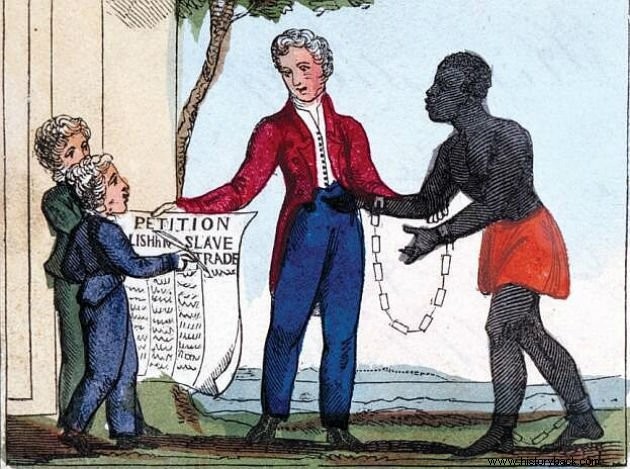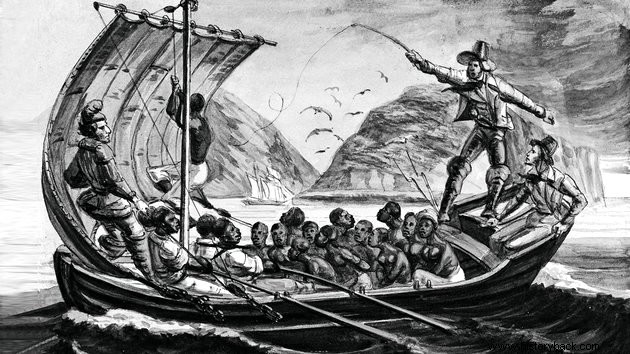The End the African Slave Trade was motivated by economic, humanitarian and religious reasons.
Throughout the 19th century, several European nations banned the slave trade and abolished slavery in their colonies due to a change in mentality and in the way of production.
Abstract
With the consolidation of the Enlightenment and liberalism, the ideas that considered black Africans as inferior beings and, therefore, subject to enslavement were being questioned.

The Negro came to be seen as an uncivilized being and it would be up to the European to civilize him on his own continent.
The factors that contributed to the success of the end of slavery were precisely those that triggered its beginning.
Religious Motives
Religion, especially the Anglican Church and Protestantism, will play an essential role in this process.
Narratives of former slaves about the condition of human commodities contributed to fuel abolitionist movements in Europe.
Gradually, the slave trade came to be classified as “trafficking”, “infamous trade” and “trade in souls”.
The thought gained popular support, reached the elite and slavery began to be morally attacked.
Churches and society began to organize themselves by promoting events and petitions calling for the end of slavery.
See also:AbolitionismEconomic Reasons
European nations, especially England, saw the African continent as a fruitful source of wealth. Maintaining the people trading system was unfeasible for the exploitation of the continent's natural resources.
This was because slave traders were, in general, chiefs and local rulers. Although they were active in the trade in people, they limited the entry of Europeans beyond the coast.
Thus, there would be a greater advantage for the exploration of the territory and the ideal workforce to work in mining and agriculture.
There were also a series of natural products that served the nascent industry such as rubber, palm oil and peanuts.
Likewise, slave labor cost less than a salaried worker. Thus, those who used slave labor would offer a cheaper product than those who paid workers.
See also:Slave ShipsCombat Trade
The process of abolishing slavery will be particular in each of the countries that used it. However, virtually everyone started by abolishing the transport of slaves to their colonies, so that the slave population would not increase.

Then, slavery was gradually abolished, starting with the emancipation of young people, or those not yet born, as was the case with the Lei do Ventre Livre in Brazil. With this, the aim was to avoid social upheavals and allow time for the transition from slave to free labor.
Also the supply of slave labor to work in the American colonies began to succumb after successive internal revolts at the end of the 18th century.
Among the most important is that of Haiti, whose independence resulted from slave revolts. The French colony was the only American possession to have its independence entirely achieved by slaves.
The first country to ban the slave trade to its colonies was Denmark in 1792.
England prohibits the trafficking of enslaved human beings in 1807 in the North Atlantic, a measure that affected the Caribbean colonies and the southern United States.
Later, he pressured both Dom João VI and Dom Pedro I to abolish the slave trade between Africa and Brazil.
However, the abolition of slavery in Brazil would be slow and gradual, with parliament controlling the process so as not to disrupt the established order.
See also:slave tradeConsequences
Slavery will leave consequences both on the African continent and in America.
Africa
Slavery in Africa left a deep mark on the continent. It is estimated that around 12 million people crossed the Atlantic to America. These could have served for their economic and intellectual development.
With the occupation of African territory and the subsequent Partition of Africa, we see an increase in ethnic wars and social disintegration.
See also:Berlin ConferenceColonies
In all countries that used slave labor we can see the same results. Afro-descendants suffer racism, are at the base of society, have lower incomes and are more likely to be poor.
Despite all this perverse effect, the black people dispersed throughout the world brought within themselves their ancestral culture, their customs, their religion and their knowledge of agriculture and animal husbandry.
In this way, they mixed their culture with that of the colonizer and the result is seen in music such as samba, tango, salsa, Cuban danzón, jazz, blues, etc.
Religions were also reinterpreted and gave rise to Candomblé, Santeria, Candombe, Umbanda, etc.
The cuisine was enriched with flavors of vegetables such as okra and yams, the constant use of beans and new ways of preparing poultry and meat.
See also:Main Features of Afro-Brazilian CultureEnd of Slavery Timeline
| 1773 | Abolished slavery in Portugal. |
|---|---|
| 1777 | End of slavery in Madeira Island. |
| 1792 | Denmark prohibits the slave trade to its Caribbean colonies, the present-day Virgin Islands (USA). It is the first country to do so. |
| 1794 | Haiti declares the end of slavery. |
| 1802 | Napoleon Bonaparte restores slavery in Haiti. |
| 1803 | The law prohibiting the slave trade to the Danish colonies takes effect. |
| 1807 | England prohibits the slave trade in the North Atlantic. Months later, the United States would ban the trade, while continuing to participate in the Caribbean trade. |
| 1810 | England gives in and allows the gradual abolition of slaves in Portuguese possessions. Only Portuguese territories in Africa could continue to traffic. |
| 1811 | Declared in Chile freedom for all those born of slavery and the end of the slave trade. |
| 1813 | Argentina decrees freedom for all those born into slavery from that date onwards. |
| 1814 | The Netherlands prohibits the slave trade. |
| 1816 | The slave trade is declared illegal in France and its colonies. |
| 1816 | Simón Bolívar grants freedom to all slaves who enlist in the Patriot Army. |
| 1817 | King Ferdinand VII prohibits the slave trade to the Spanish colonies. |
| 1821 | End the slave trade to Peru and implement a plan to end slavery gradually. |
| 1822 | Abolition of slavery in Santo Domingo. |
| 1823 | Chile prohibits slavery. |
| 1823 | Decree the abolition of slavery in the United Provinces of Central America (now Guatemala, Costa Rica, Nicaragua, El Salvador and Honduras). |
| 1826 | End slavery in Bolivia. |
| 1829 | Mexico decrees the end of slavery. |
| 1831 | The Feijó Law was enacted, which decreed free all enslaved people arriving in Brazil from that year onwards. |
| 1833 | The English Parliament abolishes slavery in the British Empire. From 1833 to 1838 slave labor was abolished in the Antilles, Belize and the Bahamas (West Indies), Guyana and Mauritius. |
| 1840 | The Swedish Parliament decrees the end of the slave trade in the colony of Saint Bartholomew, in the Caribbean. |
| 1842 | Abolished slavery in Uruguay. |
| 1845 | England prohibits the slave trade between Africa in the South Atlantic through the Bill Aberdeen Act. |
| 1847 | Abolition of slavery on the island of Saint Bartholomew, then a colony of Sweden. |
| 1848 | Denmark frees slaves in its colonies. |
| 1848 | The Second French Republic decrees the end of slavery in its colonies. |
| 1850 | The Eusébio de Queirós Law, which prohibits the trade of blacks to Brazil, was sanctioned. |
| 1851 | Abolition of slavery in Ecuador where owners were compensated for each freed slave. |
| 1852 | Abolition of slavery in Colombia. |
| 1853 | End slavery in Argentina. |
| 1854 | Venezuela and Peru decree the end of slavery |
| 1862 | Prohibition of the slave trade to Cuba. |
| 1863 | End slavery in the Dutch Antilles and Suriname colonies. |
| 1865 | The United States of America decrees the end of slavery and the southern states decide to secede from the Union. The Civil War begins. |
| 1869 | Abolished slavery in Paraguay. |
| 1869 | Decree the end of slavery in all colonies of Portugal. |
| 1871 | The Free Womb Law is enacted in Brazil. |
| 1873 | Abolition of slavery in Puerto Rico. |
| 1875 | End of slavery in São Tomé and Príncipe. |
| 1884 | Slavery is extinct in Ceará. |
| 1885 | The Law of Sexagenarians is promulgated in Brazil. |
| 1886 | End slavery in Cuba. |
| 1888 | End slavery in Brazil with the Lei Áurea. |
| 1890 | England decrees the end of slavery in Tunisia. |
| 1897 | Abolition of Slavery in Madagascar. |
| 1936 | Abolition of Slavery in Nigeria. |
| 1963 | Abolition of slavery in Saudi Arabia. |
| 1981 | End slavery in Mauritania. |
- Countries of Africa
- Black Consciousness
- Treaty of Utrecht
